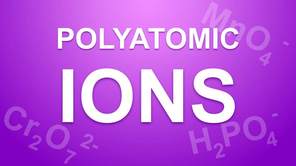Tips for Polyatomic Ions

Unfortunately when it comes to learning polyatomic ions there is no easy way to derive their chemical formula or what their charge is. However, there are a couple of tips that can potentially reduce the work by a third:
- Ions that end with the suffix -ate, have ate (eaten) an extra oxygen. e.g. PO3 --> PO4
- Ions that have both variations of -ate and -ite, still have the same charge. e.g. Sulfate and Sulfite
Year 11 chemistry students of mine can find the list of ions in a table on page 84 of their textbooks. For everyone else you can find them just as easily online from ScienceGeek.net here.
Practice Activity
Practice memorising the polyatomic ions using the quiz below, but don't forget to test your knowledge in a different array of activities, such as:
- Scatter - drag and drop matching polyatomic ion names with their formulas
- Flashcards - deselect 'both sides' on the top right. Try to name or write the responding formula or name, and click on the card to flip it over and check the answer.
- Learn - type the answer to the flashcards themselves - remember that I have used a space to separate and distinguish the charge from the formula. (e.g. PO4 space 3-)
- Speller - write the name for each polyatomic ion and check spelling.
